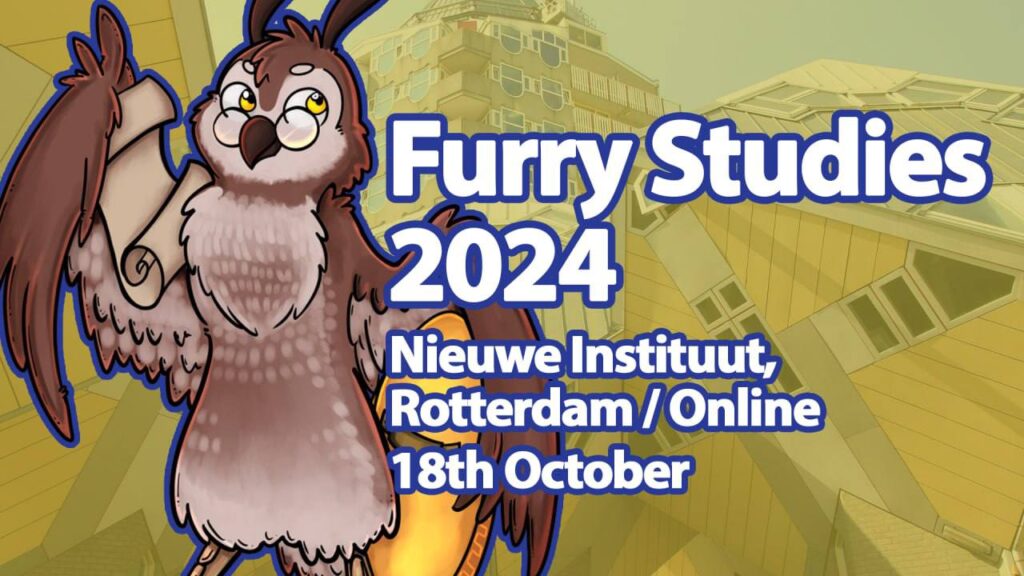
Rotterdam / Online, 18 October 2024
in association with Otterdam Furry Arts Festival (Rotterdam, the Netherlands)
Furries, loosely defined as fans of anthropomorphised animals and zoomorphic humans, are a global online phenomenon. Yet, these remain an under-researched group. This could be due to academia viewing the fandom as “unworthy” of study (Roberts, 2015) the historically negative depiction of the fandom resulting in an aversion to being studied (Leshner, et al., 2018; Plante, et al., 2017), or any of a myriad of other reasons.
The most well-known efforts to study furries come from the International Anthropomorphic Research Project (2016; 2023), however many unique perspectives on the fandom are missing or unheard. Furthermore, those studying the furry fandom are largely disconnected from each other and lack a focal point.
Theme: “Being Furry”
For the first furry studies conference, the theme, ”Being Furry”, will allow for a variety of proposals and act as a strong basis for the field’s inception. The conference aims to inspire discussion, especially given that ‘if you ask ten furries to define what furry is, you’ll end up with eleven different answers’ (Plante, 2023).
Rather than deciding on a concrete definition of “what a furry is” with this conference, our point of provocation is “What is Furry”? Here are some topics to start your thinking. This list is by no means exhaustive, and we encourage proposals about “Being Furry” that go beyond these suggestions:
- Furry history: furry media, conventions, or activities.
- Examinations of the fursona: physical ephemera, psychological attachment, aesthetics of costuming and fursuiting, species prevalence or attachment.
- Furry identity: furries and queerness, the relationships between furries and wider LGBTQIA2S+ communities, neurodiversity in the fandom, experiences of BIPOC within the community.
- Sex and the furry fandom: sex positivity, kink culture, NSFW practice and artwork.
- Furry economies: artistic output, “suspiciously wealthy furries”, furries’ charity work, the relationships between furry and ‘big media’ outputs such as Disney films.
We encourage the submission of proposals for academic papers, short workshops, practitioner-based activities, best-practice showcases, and pre-formed panels. We welcome established academics at all stages of their careers, and warmly embrace independent scholars. We also encourage submissions from non-academic furries and welcome other presentation formats such as photographic essays, alternative presentation styles, etc.
The official language of the conference, in which all submissions and eventual contributions are expected to be presented, is English. Selected papers will be developed for publication in a special issue of Popular Communication focused on furry studies.
Submission
Submissions to Furry Studies 2024 are closed. For all general enquiries, get in touch with us at hello@furrystudies.org.
References
Leshner, C.E., Reysen, S., Plante, C., Chadborn, D., Roberts, S. and Gerbasi, K.C. (2018) “My Group Is Discriminated against, but I’m Not”: Denial of Personal Discrimination in Furry, Brony, Anime, and General Interest Fan Groups, The Phoenix Papers, 4(1), pp.130-142. DOI: 0.17605/OSF.IO/27PZG.
Plante, C., Reysen, S., Roberts, S., and Gerbasi, K. (2016) FurScience! A Summary of Five Years of Research from the International Anthropomorphic Research Project, FurScience: Ontario.
Plante, C., Reysen, S., Roberts, S. and Gerbasi, K. (2017) ‘Welcome to the jungle: Content creators and fan entitlement in the furry fandom, Journal of Fandom Studies, 5(1), pp.63-80. DOI: 10.1386/jfs.5.1.63_1.
Plante, C., Reysen, S., Adams, C., Roberts, S., Gerbasi, K. (2023) Furscience: A Decade of Psychological Research on the Furry Fandom, Furscience: Texas.
Roberts, S. (2015) Marginalization of Anthropomorphic Identities: Public Perception, Realities, and “Tails” of being a Furry Researcher, in Thurston Howl (ed.) Furries Among Us: Essays on Furries by the Most Prominent Members of the Fandom, Thurston Howl Publications: Nashville.